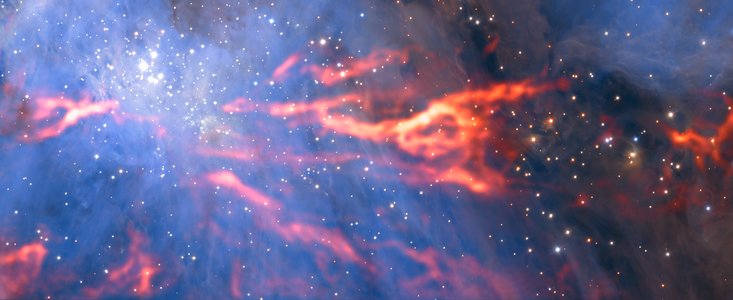Stellar Nursery Unites Star-Formation Theories
Enormous filaments within the solar system's closest massive region of star formation are made up of wispy fibers of cold gas. New observations have revealed these fibers in exquisite detail, helping scientists to compare the enormous star-formation region with other, smaller clouds and move toward a unified model of star formation under different environments.
"The detection of fibers in Orion opens a new window on the description of the internal gas structure in massive clouds," wrote astronomer Alvaro Hacar Gonzalez, of the Netherlands' Leiden University. "Since their discovery, different studies have reported the detection of fibers in isolated and clustered star-forming environments."
Hacar Gonzalez led a team of researchers who studied one of the Orion nebula's most massive filaments, a region in the northern portion of the Orion A molecular cloud called the Integral Shape Filament (ISF), which stretches nearly 23 light-years in length. While the ISF is massive, there are other, smaller star-formation clouds that also host smaller filaments, which have been better characterized. Previous research has argued that there should be a direct link between the massive filaments and their low-mass counterparts, but astronomers have been stymied by an inability to reach the sensitivities necessary to probe the more massive filaments. [Zoom Through the Famous Orion Nebula with NASA's Incredible 3D Video]

By combining observations from the European Southern Observatory's (ESO) Atacama Large Millimeter/submillimeter Array (ALMA) and several other telescopes, Hacar Gonzalez and his colleagues were able to probe these regions for the first time. They found that the structures resembled their smaller cousins, suggesting that the two types of structures might have more similar star-formation processes than scientists previously thought.
"Our new ALMA observations demonstrate that this underlying organization is not restricted to low-mass clouds, but [is] also intrinsic of regions at higher-mass regimes," Hacar Gonzalez wrote in the new paper, published in the journal Astronomy & Astrophysics in February.
A unified star-formation theory
Located about 1,350 light-years from Earth, the Orion Nebula is the solar system's closest massive star-formation region. Its proximity has made it a target for astronomers working to understand how stars form and evolve in their first few million years. Stars are born when dense clouds of gas and dust begin to collapse under their own gravity. The resulting protostar eventually grows into a full-fledged star.
Get the Space.com Newsletter
Breaking space news, the latest updates on rocket launches, skywatching events and more!
The Orion Nebula is made up of cold gas, visible only in the millimeter wavelength. That makes ALMA one of the only instruments capable of probing structures such as the ISF. Over the past few million years, the ISF has spawned several thousand young stars, and it contains dozens, if not hundreds, of embedded young stellar objects.
"The ISF is one of the best-studied massive filaments, and is usually employed as a benchmark for clustered star-formation theories," Hacar Gonzalez wrote.
The researchers were able to hunt for the cold, charged gas called diazenylium that makes up the ISF and identify a network of 55 fibers within the filament. By combining ALMA's observations with those made by the Millimetric Radioastronomy Institute's (IRAM) 30-meter telescope in the Spanish Sierra Nevada and the more familiar view by the ESO's Very Large Telescope, scientists were able to create the engaging new image and probe the thin fibers hiding within the enormous filament.
In addition to identifying the fibers, the team found an intricate network of gas within the massive ISF. Prominent clumps split into multiple independent substructures, which went on to branch into smaller filamentary features. The hierarchal organization resembles the bundles of fibers found in low-mass filaments and intermediate-mass clusters, according to the scientists.
"Investigating the internal structure of massive filaments is of crucial importance for the description of the star formation process in the Milky Way," Hacar Gonzalez wrote. "The widespread detection of fibers seems to reflect the preferred organization mechanism for the dense molecular gas within clouds."
The fibers don't just share a structure with their smaller counterparts. By comparing them to existing studies of other, smaller regions, the team found other similar characteristics. These similarities, which include surface density of the star-forming fibers, suggest that star formation in smaller clouds of gas works much as it does in larger regions.
"Based on this empirical correlation, we propose a unified star-formation scenario where the observational differences between low- and high-mass clouds, as well as both isolated and clustered regimes, naturally emerge from their initial concentration of fibers," Hacar Gonzalez wrote.
Follow Nola Taylor Redd at @NolaTRedd, Facebook, or Google+. Follow us at @Spacedotcom, Facebook or Google+. Originally published on Space.com.
Join our Space Forums to keep talking space on the latest missions, night sky and more! And if you have a news tip, correction or comment, let us know at: community@space.com.

Nola Taylor Tillman is a contributing writer for Space.com. She loves all things space and astronomy-related, and enjoys the opportunity to learn more. She has a Bachelor’s degree in English and Astrophysics from Agnes Scott college and served as an intern at Sky & Telescope magazine. In her free time, she homeschools her four children. Follow her on Twitter at @NolaTRedd









